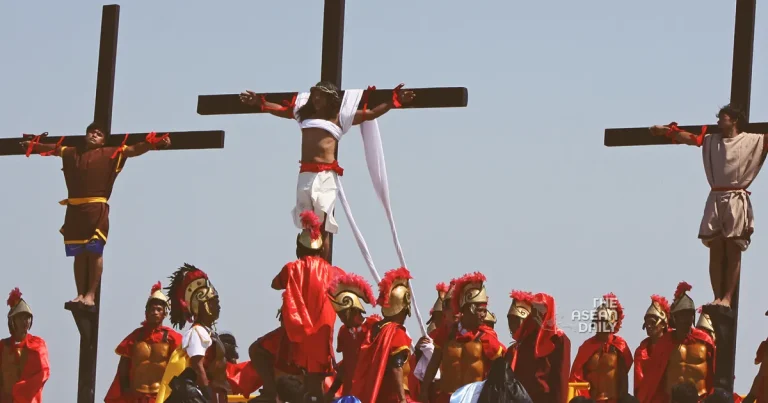29-3-2024 (MANILA) In a powerful display of faith and reverence, a Filipino villager is preparing to be nailed to a wooden cross for the 35th time, reenacting the suffering of Jesus Christ in a brutal Good Friday tradition. Ruben Enaje, a 63-year-old carpenter and sign painter, revealed his intention to devote this year’s crucifixion to praying for peace in Ukraine, Gaza, and the disputed South China Sea.
Enaje, along with seven other villagers, has registered for the real-life crucifixions, which have become an annual religious spectacle drawing hundreds of tourists to three rural communities in Pampanga province, north of Manila. The gory ritual resumed last year after a three-year hiatus due to the coronavirus pandemic, cementing Enaje’s status as a village celebrity for his role as the “Christ” in the Lenten reenactment of the Way of the Cross.
In a conversation with The Associated Press on Thursday night, Enaje admitted that he had considered ending his annual religious penitence due to his age but felt compelled to continue in response to villagers’ requests for him to pray for sick relatives and various other afflictions.
The need for prayers, he explained, has intensified during this alarming period of global conflicts and wars. “If these wars worsen and spread, more people, especially the young and old, would be affected. These are innocent people who have totally nothing to do with these wars,” Enaje lamented.
Despite the geographic distance, the wars in Ukraine and Gaza have contributed to soaring prices of oil, gas, and food, including in the Philippines, making it increasingly difficult for impoverished individuals to make ends meet, he added.
Closer to home, the escalating territorial dispute between China and the Philippines in the South China Sea has also sparked worries, as Enaje acknowledged the stark imbalance of power. “China has many big ships. Can you imagine what they could do?” he asked.
“This is why I always pray for peace in the world,” Enaje affirmed, adding that he would also seek relief for people in southern Philippine provinces recently affected by flooding and earthquakes.
Enaje’s devotion to the crucifixion ritual dates back to the 1980s when he miraculously survived a nearly fatal fall from a three-story building. Since then, he has undergone the crucifixion as an act of thanksgiving, extending the ritual as loved ones recovered from serious illnesses and he secured more carpentry and sign-painting job contracts.
During the annual crucifixions on a dusty hill in Enaje’s village of San Pedro Cutud and two other nearby communities, he and other religious devotees, adorned with thorny crowns of twigs, carry heavy wooden crosses on their backs for more than a kilometer (more than half a mile), often enduring the scorching summer heat. Village actors dressed as Roman centurions later hammer 4-inch (10-centimeter) stainless steel nails through their palms and feet, then set them aloft on wooden crosses under the sun for about 10 minutes as a large crowd prays and snaps pictures.
Other penitents walk barefoot through village streets and beat their bare backs with sharp bamboo sticks and pieces of wood. Some participants in the past have even opened cuts in the penitents’ backs using broken glass to ensure the ritual is sufficiently bloody.
Many of the mostly impoverished penitents undergo the ritual to atone for their sins, pray for the sick or for a better life, and give thanks for miracles, reflecting the Philippines’ unique brand of Catholicism that merges church traditions with folk superstitions.
While church leaders in the Philippines, the largest Catholic nation in Asia, have frowned upon the crucifixions and self-flagellations, urging Filipinos to show their faith and religious devotion through charity work instead, such as donating blood, the tradition has endured for decades.




